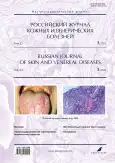Метаболомный скрининг как инструмент оценки патогенеза и течения псориаза
- Авторы: Олисова О.Ю.1, Кукес В.Г.1, Кукес И.В.1, Игнатьев Д.В.1, Рогачева В.В.1
-
Учреждения:
- Первый Московский государственный медицинский университет имени И.М. Сеченова
- Выпуск: Том 25, № 3 (2022)
- Страницы: 201-209
- Раздел: ДЕРМАТОЛОГИЯ
- URL: https://journals.rcsi.science/1560-9588/article/view/109075
- DOI: https://doi.org/10.17816/dv109075
- ID: 109075
Цитировать
Аннотация
Псориаз ― хроническое, аутовоспалительное/аутоиммунное системное заболевание кожи. Этиология и патогенез заболевания до сих пор неясны. При псориазе наблюдаются активация Th17/IL-17 и аномалии в оси баланса Th17/Treg, однако этот патомеханизм не полностью объясняет частые метаболические нарушения. Именно поэтому необходимо искать лучшие биомаркеры в диагностике, прогнозе и мониторинге сопутствующих расстройств и терапевтических эффектов при псориазе.
Метаболомика ― новая технология, позволяющая выявлять совокупность маломолекулярных химических веществ, участвующих в метаболизме. Этот метод традиционно используется в диагностике и прогнозировании заболевания. Метаболомный скрининг имеет важное значение для клинической диагностики, терапевтического мониторинга, прогнозирования эффективности лечения псориаза и дальнейшего открытия новых терапевтических мишеней на основе метаболизма.
Фармакометаболомика направлена на прогнозирование индивидуальных различий в реакции на лечение и в развитии побочных эффектов, связанных с конкретными лекарственными препаратами.
В представленном обзоре суммируются исследования, которые показывают реакции на медикаментозное лечение на основе их метаболических профилей, полученных до, во время или после терапевтического вмешательства.
Ключевые слова
Полный текст
Открыть статью на сайте журналаОб авторах
Ольга Юрьевна Олисова
Первый Московский государственный медицинский университет имени И.М. Сеченова
Автор, ответственный за переписку.
Email: olisovaolga@mail.ru
ORCID iD: 0000-0003-2482-1754
SPIN-код: 2500-7989
д.м.н., профессор
Россия, МоскваВладимир Григорьевич Кукес
Первый Московский государственный медицинский университет имени И.М. Сеченова
Email: elmed@yandex.ru
ORCID iD: 0000-0002-5112-6928
SPIN-код: 8498-3521
д.м.н., профессор, академик РАН
Россия, МоскваИлья Владимирович Кукес
Первый Московский государственный медицинский университет имени И.М. Сеченова
Email: ilyakukes@gmail.com
ORCID iD: 0000-0003-1449-8711
SPIN-код: 1166-3569
к.м.н., н.с.
Россия, МоскваДмитрий Владимирович Игнатьев
Первый Московский государственный медицинский университет имени И.М. Сеченова
Email: dmitrywork@list.ru
ORCID iD: 0000-0001-8751-3965
SPIN-код: 6743-7960
MD
Россия, МоскваВероника Валерьевна Рогачева
Первый Московский государственный медицинский университет имени И.М. Сеченова
Email: rogacheva-90@mail.ru
ORCID iD: 0000-0003-4200-7887
SPIN-код: 6164-1817
аспирант
Россия, МоскваСписок литературы
- Yang G., Xia Y., Ren W. Glutamine metabolism in Th17/Treg cell fate: applications in Th17 cell-associated diseases // Science China Life Sci. 2021. Vol. 64, N 2. Р. 221–233. doi: 10.1007/s11427-020-1703-2
- De Berardinis R.J., Mancuso A., Daikhin E., et al. Beyond aerobic glycolysis: transformed cells can engage in glutamine metabolism that exceeds the requirement for protein and nucleotide synthesis // Proc Natl Acad Sci USA. 2007. Vol. 104, N 49. Р. 19345–19350. doi: 10.1073/pnas.0709747104
- Carr E.L., Kelman A., Wu G.S., et al. Glutamine uptake and metabolism are coordinately regulated by ERK/MAPK during T lymphocyte activation // J Immunology. 2010. Vol. 185, N 2. Р. 1037–1044. doi: 10.4049/jimmunol.0903586
- Johnson M.O., Wolf M.M., Madden M.Z., et al. Distinct regulation of Th17 and Th1 cell differentiation by glutaminase-dependent metabolism // Cell. 2018. Vol. 175, N 7. Р. 1780–1795.e19. doi: 10.1016/j.cell.2018.10.001
- Klysz D., Tai X., Robert P.A., et al. Glutamine-dependent α-ketoglutarate production regulates the balance between T helper 1 cell and regulatory T cell generation // Sci Signal. 2015. Vol. 8, N 396. Р. ra97. doi: 10.1126/scisignal.aab2610
- Lian, G., Gnanaprakasam, J.R., Wang, T., et al. Glutathione de novo synthesis but not recycling process coordinates with glutamine catabolism to control redox homeostasis and directs murine T cell differentiation // Elife. 2018. Vol. 7. Р. e36158. doi: 10.7554/eLife.36158
- Lian N., Shi L.Q., Hao Z.M., Chen M. Research progress and perspective in metabolism and metabolomics of psoriasis // Chin Med J. 2020. Vol. 133, N 24. Р. 2976–2986. doi: 10.1097/CM9.0000000000001242
- Gauza-Włodarczyk M., Kubisz L., Włodarczyk D. Amino acid composition in determination of collagen origin and assessment of physical factors effects // Int J Biol Macromol. 2017. Vol. 104, Pt A. Р. 987–991. doi: 10.1016/j.ijbiomac.2017.07.013
- Smith R.J., Phang J.M. The importance of ornithine as a precursor for proline in mammalian cells // J Cell Physiol. 1979. Vol. 98, N 3. Р. 475–481. doi: 10.1002/jcp.1040980306
- Сускова В.С., Пинсон И.Я., Олисова О.Ю. Иммунопатогенез псориаза // Клиническая дерматология и венерология. 2006. № 1. С. 68–70.
- Tashiro T., Sawada Y. Psoriasis and systemic inflammatory disorders // Int J Mol Sci. 2022. Vol. 23, N 8. Р. 4457. doi: 10.3390/ijms23084457
- Bilgiç Ö., Altınyazar H.C., Baran H., Ünlü A. Serum homocysteine, asymmetric dimethyl arginine (ADMA) and other arginine-NO pathway metabolite levels in patients with psoriasis // Arch Dermatol Res. 2015. Vol. 307, N 5. Р. 439–444. doi: 10.1007/s00403-015-1553-3
- Kamleh M.A., Snowden S.G., Grapov D., et al. LC-MS metabolomics of psoriasis patients reveals disease severity-dependent increases in circulating amino acids that are ameliorated by anti-TNFα treatment // J Proteome Res. 2015. Vol. 14, N 1. Р. 557–566. doi: 10.1021/pr500782g
- Kapoor S.R., Filer A., Fitzpatrick M.A., et al. Metabolic profiling predicts response to anti-tumor necrosis factor α therapy in patients with rheumatoid arthritis // Arthritis Rheum. 2013. Vol. 65, N 6. Р. 1448–1456. doi: 10.1002/art.37921
- Kang H., Li X., Zhou Q., et al. Exploration of candidate biomarkers for human psoriasis based on GC-MS serum metabolomics // Br J Dermatol. 2017. Vol. 176, N 3. Р. 713–722. doi: 10.1111/bjd.15008
- Madsen R.K., Lundstedt T., Gabrielsson J., et al. Diagnostic properties of metabolic perturbations in rheumatoid arthritis // Arthritis Res Ther. 2011. Vol. 13, N 1. Р. R19. doi: 10.1186/ar3243
- Ottas A., Fishman D., Okas T.L., et al. The metabolic analysis of psoriasis identifies the associated metabolites while providing computational models for the monitoring of the disease // Arch Dermatol Res. 2017. Vol. 309, N 7. Р. 519–528. doi: 10.1007/s00403-017-1760-1
- Souto-Carneiro M., Tóth L., Behnisch R., et al. Differences in the serum metabolome and lipidome identify potential biomarkers for seronegative rheumatoid arthritis versus psoriatic arthritis // Ann Rheum Dis. 2020. Vol. 79, N 4. Р. 499–506. doi: 10.1136/annrheumdis-2019-216374
Дополнительные файлы







